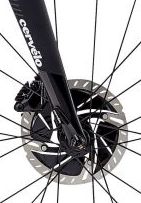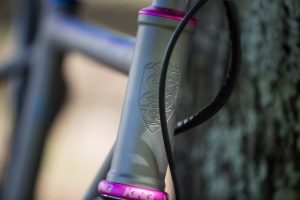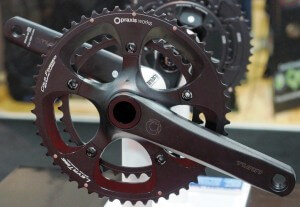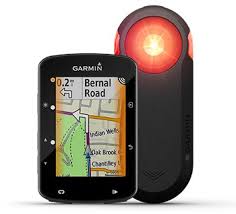Best Cycling Equipment Purchases, Part 3
From fit to electronic shifting and wheels, Part 1 and Part 2 of this series have explored a lot of great innovations in the bike industry in recent years. While there are many additional products and services worthy of consideration, Part 3 will be the last in this series… Here are some more places I have experienced major advances in technology in a short period of time.
Gearing.
While we always welcome more gearing options, today’s factory gearing options are so much better than they used to be.
The 46/33 10-33 combination on the SRAM AXS components I rode on my first commute of the year is a savior. Out of shape and doing 45+ miles on your first ride goes against what I preach in bike fittings, but it was the reality of my first ride this year. Thinking back on how I would have been doing this on a 53/39 with a 12-23 25 years ago made it obvious why some people just stopped riding bikes. Things are thankfully different now.
We sometimes joke that gearing has become the “new“ weight for road bikes. We talk more about what gearing is available today than how light new bike models are. Setting up road bikes with well below a 1-to-1 sometimes feels like it is “normal” at Fit Werx. Advances in gearing keep more people riding more terrain longer and that is a good thing. It is hard to believe, but compact gearing has been out 15 years now and that was only the beginning. New bike or updating an old favorite, don’t push gearing that hinders your riding or rides.
BTW – SRAM, if you are listening, it would be great to see either a 30 up-front or a 36T (or lower) in the back with AXS in the future. Same goes for similar options from Shimano, Campagnolo and the others! Whoever makes it first will earn more than a couple sales.
Hydraulic Disc Brakes.
I’m not going to tell you that you “need” disc brakes if you don’t have them. You don’t. One of my favorite bikes remains a caliper brake equipped Moots Vamoots RSL. It is well under 14 lbs  ready to ride and it is the best climbing bike I own…
ready to ride and it is the best climbing bike I own…
This being said, disc brakes are worth their few considerations for almost everyone. If I had one road bike, it would have disc brakes. Why?
- I generally don’t like going out in the rain on my bike. This spring has forced the issue though. The first three miles of my commute is down fairly steep roads. Even if it were dry, disc brakes make this a notably quicker and safer feeling descent. The power and modulation of a good hydraulic disc brake are hard to even compare to a caliper brake.
- Tire width. While today’s caliper brakes and frames allow for more tire width options, they are still well behind what is often allowed with disc brakes. Disc brakes are why the entire “gravel road” category, likely the most popular road bike category in the U.S. right now, exists. A good number of road bikes from not that long ago won’t even accept a tire that measures wider than 23mm. Today, tires that measure 26-30mm in mounted width have become the standard on many performance pavement and aero bikes even.
- Power and modulation. Disc brakes offer more consistent and stronger braking. You can brake later and more powerfully. That caliper brake on the bike I mentioned above pales in slowing capability to my disc brake bikes.
A Great Frame.
I’ve been lucky to own and ride a lot of really nice riding bike frames through the years. 
While I fit on many stock bikes just fine, the most revelatory jump I experienced in my cycling perceptions came with my first custom bike about twenty years ago. The quality of the build, fit and ride on that Serotta Ottrott changed how I thought about bikes. In fact, this bike fit and rode so well that it played a role in Fit Werx becoming a reality.
Production bikes have come a long way since then. Who would have thought that modern aero road bikes like the 2019 Parlee RZ7 and Cervelo S3 could ever be as fast and ride as well as they do hile looking so great? Likewise, ten years ago, who would have thought tires with 28mm+ of measured contact width would be so popular on pavement?
Whether it is stock or custom, bikes have come a long way in a short time. On the road bike side, the past five years have shown more progression in design, performance and awareness than the thirty years prior. The frame is the part that determines whether you can use all the new developments. When it comes to mountain bike frame geometry and sizing, today’s bikes seem like they are from a different planet compared to a bike of a couple decades ago.
Even if you have a great frame from 15 years ago, it is hard to get off an equivalent level bike of today and not feel like things have come a long way. The 20% greater lateral stiffness of thru-axles and over-sized forks, more tire contact, electronic shifting and hydraulic brakes are all major advancements.
The Moots Routt RSL I commute on has 36mm tires and is under 1 mph slower on the pavement than my fastest road tires and frame. The frame is so good that with 25-28mm tires, it wouldn’t be the bike’s fault when I fall off the back of a group ride. The versatility the right frame of today offers allows one bike to take the place of many.
Shorter Cranks.
This one isn’t for everyone, but if you are having joint issues, struggle with a slow cadence or are 5’8” or shorter, you should know that shorter cranks could help you ride more comfortably and  pedal better. I’m 5’7” and swapped half my bikes from 170mm to 165mm over the past couple years. I really like what shorter cranks on my mountain bike does for dramatically cutting back on pedal contact with the ground. On my road bikes, it helps me come through the top and bottom of the stroke easier; I feel like my stroke is smoother and faster. It is another place where the research disproved some of the common thought and changed minds; it has made a difference in my riding.
pedal better. I’m 5’7” and swapped half my bikes from 170mm to 165mm over the past couple years. I really like what shorter cranks on my mountain bike does for dramatically cutting back on pedal contact with the ground. On my road bikes, it helps me come through the top and bottom of the stroke easier; I feel like my stroke is smoother and faster. It is another place where the research disproved some of the common thought and changed minds; it has made a difference in my riding.
Garmin Varia Radar System.
First, let me say that, despite what I do for a living, most of my riding is computer free. It has been a long time since I have raced and data from my rides in recent years would only prove more depressing than helpful. This being said, I own a pricey Garmin computer that I own for one primary purpose – to use the Garmin Varia Radar System.
While it sounds gimmicky, the Garmin Varia Radar System is one of the best safety inventions for bikes ever concocted. It has turned skeptics into disciples in a single ride and it is deserving of its  own post. Why? It is a super high tech safety lighting system paired with an unobtrusive and very helpful way to see what is coming from behind without having to turn your head. Enough said.
own post. Why? It is a super high tech safety lighting system paired with an unobtrusive and very helpful way to see what is coming from behind without having to turn your head. Enough said.
I’m certain the Garmin Varia radar system has saved lives and I look forward to the day when Varia, or something like Varia, is “standard safety equipment”. Now in its second generation, you should get one. You’ll appreciate it, as will your family and friends.
Contact us for more information on the Garmin Varia or to order.
Conclusions:
The bike industry moves very quickly. There was a day years ago when the U.S. Patent office had an entirely separate office just to handle the volume of patent requests for bikes. I’ve even heard that the bike industry gives the computer industry a run for its money in this department today.
Even if you are riding a great bike from only 5-10 years ago, a lot has changed. While this has added some complexity to the build of the bike, it has also enhanced the way bikes work. We recently delivered a pair of Parlee XDR bikes to a couple of accomplished riders who have owned very nice bikes over the years – they have owned full carbon wheels and sub 15 lbs bikes for many years. Every time I see them they comment on how blown away they are at how well these new bikes ride and how much things have progressed in such a short period of time. He says the bikes have taken years off his climbing in particular. I agree.
While I’m still out of shape and many, many miles out of my peak, just riding my bike to work and back reminds me that equipment and set-up matters more than ever. Enjoy the ride!

